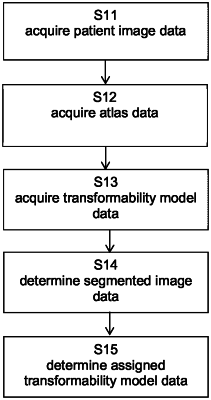| CPC G06T 7/11 (2017.01) [G06T 7/0012 (2013.01); G06T 7/20 (2013.01); G06T 7/70 (2017.01); G06T 2207/20128 (2013.01); G06T 2207/30081 (2013.01)] | 20 Claims |

|
1. A computer-implemented method, comprising:
acquiring patient image data describing a patient image of an anatomical body part of a patient;
acquiring atlas data describing a model of the anatomical body part and at least one value of at least one parameter of a geometric transformability model of the anatomical body part;
acquiring transformability model data describing the geometric transformability model of the anatomical body part;
determining segmented image data based on the patient image data and the atlas data and the transformability model data, the segmented image data describing a segmentation of the patient image and a geometric relation between the geometric transformability model and the segmentation; and
determining assigned transformability model data based on the segmented image data and the atlas data, the assigned transformability model data describing an assignment of the at least one value of the at least one parameter to the geometric relation between the geometric transformability model and the segmentation,
wherein the geometric transformability model contains boundary conditions for movement of anatomical structures relative to each other and/or boundary conditions for deformation of the anatomical structures relative to one another, the anatomical structures being part of the anatomical body part and being at least two disjunct anatomical structures.
|